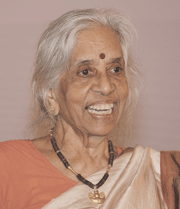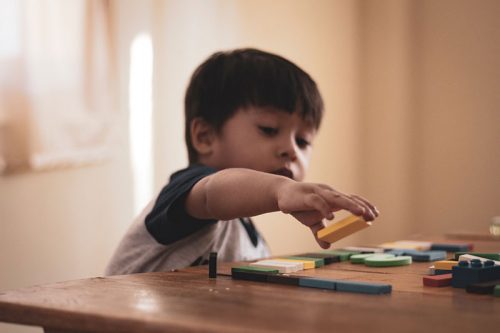Focus on young children and play: Keynote address by Dr. S. Anandalakshmy
 I would like to begin with a true story, an episode of a few decades ago. A young woman had come to her parental home during her first pregnancy. Her father was a reputed doctor in a small temple town called Srivilliputtur. The delivery was normal and the baby was healthy. Baths and diets were all taken care of in traditional style.
I would like to begin with a true story, an episode of a few decades ago. A young woman had come to her parental home during her first pregnancy. Her father was a reputed doctor in a small temple town called Srivilliputtur. The delivery was normal and the baby was healthy. Baths and diets were all taken care of in traditional style.
When the baby was five months old, travel arrangements were made for the mother and baby. New clothes for her husband’s family, and loads of the customary sweets and snacks, personal effects of the young mother and the infant’s silver cup and spoon — all were packed. Every detail was checked and they reached the station in the doctor’s car followed by a jutka (horse-cart) with the luggage. When they reached the station, each asked the other, “Who is holding the baby”? No one was. They rushed back to find the baby fast asleep in his crib, where he had been forgotten. They managed to get back to the railway station in time, catch the train, with the baby safe in the mother’s arms. A happy ending!
You might wonder how this anecdote is connected to the theme of focusing on young children. Well, it’s a metaphor for what often happens in schools and particularly in preschools. There is a curriculum, neatly typed on every table, daily time tables up on the wall, age-appropriate play materials, colourful furniture, the loud school bell, well-turned out and often well-trained teachers, and airy classrooms. The focus is on the setting. In the process of organising everything, the child is often neglected.
And such diffusion of focus is not only in schools. I have attended seminars and conferences on early childhood, where one would hear three or four learned presentations in a session, with no specific mention of the words “child” or “children”. Of course, the child’s presence was implicit, but I am keen to make that presence explicit and remind this audience of the wonderful talent children have for creativity and spontaneity.
Odi vilayadu paappa is the first line of a well-known song by freedom fighter and patriot-poet Subramania Bharati. It’s addressed to a young girl, urging her to run and play with her friends and be joyful. It celebrates childhood and the spontaneous play of young children.
The play experiences of children form the first source of their education. As teachers, through our interventions we should guide and stimulate, nurture them through play, assisting them to enhance their observations, allowing each child to make joyful discoveries of nature. We should promote their talent for forming natural friendships, provide settings where they can develop confidence and sense of self. Singing, dancing, miming, story-telling, painting and clay modeling are activities in which every child can participate and experience delight and empowerment.
Most parents focus on cognitive learning or the development of specific physical skills, which result when children play. What adults often miss is the emotional development inherent in play activities. Starting with including a newcomer or ensuring that no one in the group is treated unfairly, several kinds of emotional intelligences are enhanced during children’s play.
Cooperation among themselves is one of the fundamental principles in children’s play. They will not be able to play even a simple game of Hide and Seek without all of them agreeing to the rules and adhering to them. Sometimes when a younger or handicapped child joins a group, a consensus will soon develop on making some concession on distance or speed or scoring for that child. This happens as part of group dynamics, if the group is congenial and has no bullies.
Everything a child learns is through observation, imitation and playing. Children who investigate the world around them should be supported and encouraged. A dominant adult’s presence could be overpowering and hence counter-productive to children’s natural learning. However, a caring adult’s presence is both a necessity and advantage in the early years.
You may know that doctors are required to take the Hippocratic Oath, a kind of honour code for the practice of their profession. I find there is no equivalent code for teachers. I have therefore created a Socratic Oath for teachers. The oath varies a little depending on the age of pupils. Towards making it relevant for early childhood educators, I have adapted it slightly for them and for caregivers of the very young.
The Socratic Oath for preschool teachers I have devised reads as under:
• I will always listen to children in my care and not dominate the class or scare them. In the process, I will get to know each child.
• I will not make comparisons of children with each other or rank them and I will make sure there is no gender, class or caste bias in my class.
• While acknowledging that some rules are necessary for the regular functioning of my class, I will always consider the context in which any rule is administered and permit myself some flexibility.
• Accepting that all children are creative and original, I will avoid monotony and provide a variety of situations for children’s self-expression.
• I will not punish any child physically or by humiliation, remembering that compassion and a sense of fairness are the best tools for discipline.
• I will treat parents of the children in my care as friends, who are concerned with their children’s development and well-being.
• I will be inclusive in my approach and not allow any child to be isolated or rejected because of disability or difference. I will strive to create a classroom where children are happy.
(Dr. S. Anandalakshmy is former director of Lady Irwin College, Delhi and currently advisor to several NGOs)
















Add comment